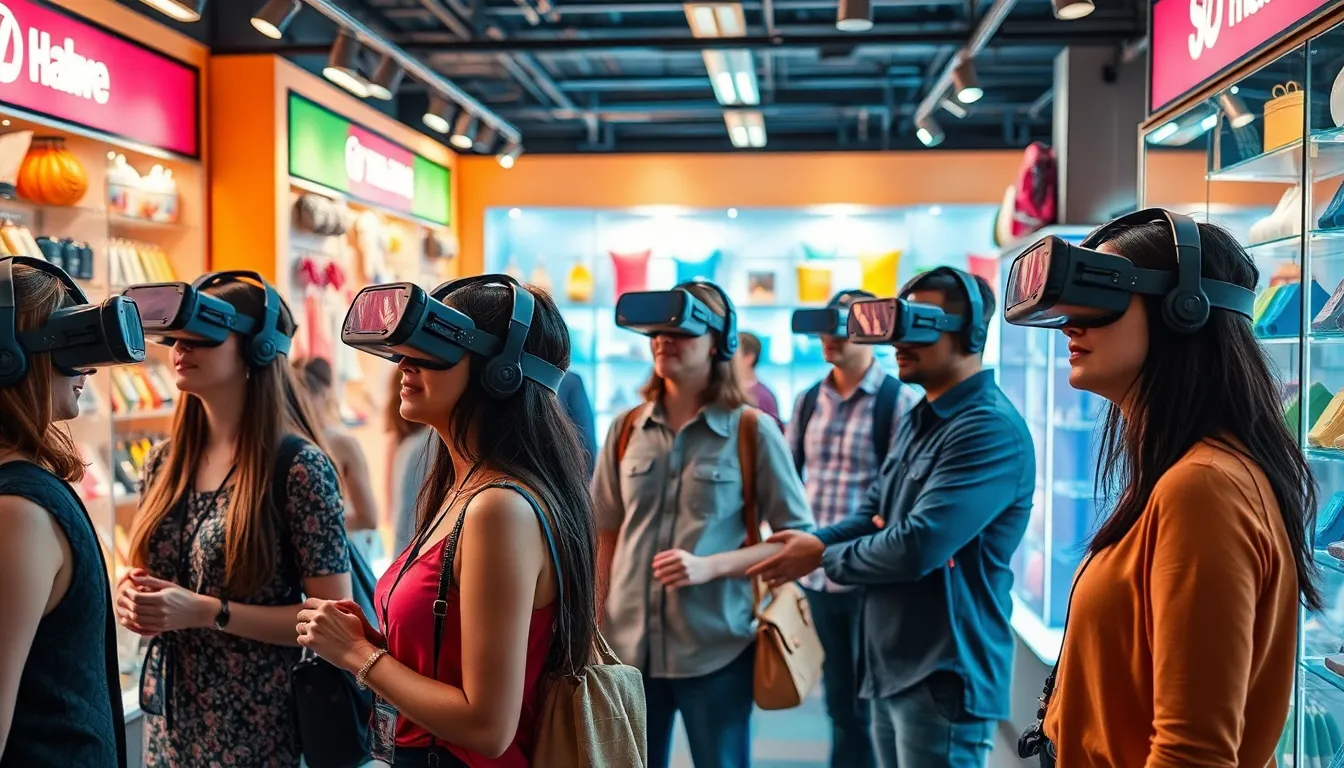Table of Contents
ToggleImagine stepping into a world where shopping feels like a thrilling adventure rather than a chore. Welcome to the VR marketplace, where virtual reality transforms the way people buy and sell. Gone are the days of endless scrolling through boring product lists. In this immersive realm, customers can try on clothes without ever leaving their couch or explore exotic locales while sipping coffee at home.
Overview of VR Marketplace
A VR marketplace offers an immersive shopping environment where users interact within a three-dimensional space. Innovations in technology enable customers to browse products as if they’re physically present in a store. Enhanced visualization tools allow shoppers to examine items from different angles, resulting in informed purchasing decisions.
Retailers in these marketplaces benefit from reduced overhead costs associated with physical stores. It creates opportunities for brands to reach a global audience without traditional location constraints. Consumers can find a wide range of products, from fashion to home decor, all in one virtual location.
The integration of social features adds a communal aspect to the shopping experience. Shoppers can interact with friends, seeking opinions before making purchases. Additionally, many VR marketplaces promote personalized recommendations through AI, tailoring the experience according to individual preferences.
Statistics indicate that VR in retail can increase conversion rates significantly. According to a study by PwC, immersive shopping can boost sales by up to 30 percent compared to standard online platforms. With the rise of e-commerce, these marketplaces position themselves as the future of retail.
Security features remain a priority, ensuring safe transactions in these virtual environments. As users navigate these marketplaces, encrypted payment methods provide peace of mind. Exploring these innovations illustrates how VR marketplaces redefine shopping experiences in a fast-evolving digital landscape.
Key Features of VR Marketplaces

VR marketplaces offer unique features that enhance the shopping experience for users. They prioritize user experience and security measures to create a reliable environment.
User Experience
Immersive navigation allows users to move through a virtual store as if they’re physically there. Engaging visuals showcase products, enabling shoppers to examine items closely. Different angles add depth to product views. Real-time interaction lets users communicate with friends, making shopping a social activity. Personalized recommendations, powered by AI, tailor the experience to match individual tastes. Statistics show that incorporating these features boosts user satisfaction, enhancing the likelihood of purchases. Overall, a more interactive shopping experience leads to higher engagement and increased conversion rates.
Security Measures
VR marketplaces place a strong focus on security measures to protect users. Encrypted payment methods ensure safe transactions during purchases. Robust authentication processes prevent unauthorized access to user accounts. Regular updates safeguard against potential cybersecurity threats. Compliance with industry regulations adds an additional layer of protection for user data. Trust is critical in online shopping, and enhanced security measures create a safe environment where users can shop without worry. With these features, VR marketplaces foster confidence in customers and encourage repeat visits.
Top VR Marketplaces
Several VR marketplaces are gaining traction, each offering unique features and benefits tailored to enhance the shopping experience.
Marketplace 1: Features and Benefits
This marketplace emphasizes user immersion, allowing shoppers to explore products in lifelike environments. Enhanced visualization techniques give buyers the chance to examine items in 3D, which fosters informed decisions. With social features integrated, users can shop together with friends, making the experience more engaging. The use of AI accelerates personalization, delivering recommendations based on previous interactions. Sellers benefit from lower operational costs, expanding their reach to a global audience without the physical limitations of traditional stores.
Marketplace 2: Features and Benefits
This platform prioritizes interactivity, enabling customers to virtually try on clothing and accessories. Live demonstrations showcase products in a way that standard ecommerce cannot achieve. Shoppers can connect with friends in real-time, sharing opinions and experiences instantly. Customization options further enhance the experience, allowing users to tailor their shopping environment. Analytics tools provide sellers with insights into consumer behavior, driving smarter inventory management and marketing strategies.
Marketplace 3: Features and Benefits
This specific marketplace focuses on community engagement, inviting users to participate in live events and more. Gamification elements introduce fun into shopping, encouraging exploration through rewards and challenges. Users experience a secure payment process, benefiting from encryption and strong authentication methods. Comprehensive support systems offer assistance at every step, ensuring that customer inquiries are addressed promptly. Partnerships with popular brands expand the marketplace’s inventory, offering diverse products to a discerning clientele.
Challenges in the VR Marketplace
VR marketplaces face several challenges that impact their growth and user experience. Technical limitations and market adoption hurdles contribute to these ongoing obstacles.
Technical Limitations
Processing power requirements can hinder the VR experience. High-quality graphics and real-time interactions demand advanced hardware, which many users lack. Compatibility issues across various devices may create additional barriers. Limited internet bandwidth affects the immersive experience, resulting in lag and discomfort. Development complexity also poses challenges; creating engaging, interactive environments requires skilled developers and significant resources. These technical factors impede the overall accessibility of VR marketplaces.
Market Adoption
User resistance stems from unfamiliarity with VR technology. Some individuals view the expense of VR headsets and equipment as prohibitive. Moreover, a lack of compelling content can deter potential consumers from fully embracing VR shopping. Market fragmentation further complicates adoption, with various platforms competing for users’ attention. Retailers also face uncertainty about return on investment when entering this emerging market. Despite these challenges, ongoing advancements in technology and increased awareness present opportunities for growth.
Future Trends in the VR Marketplace
Emerging trends in the VR marketplace indicate significant advancements in user experience. Continued integration of artificial intelligence enhances personalization, allowing retailers to provide targeted recommendations based on individual shopping habits. This development increases the likelihood of conversions, reflecting a potential 30 percent boost in sales compared to traditional platforms.
Next, gamification features are gaining popularity as a means to engage users more deeply. By incorporating elements like rewards and challenges, VR marketplaces can make the shopping process fun and interactive. Shoppers are likely to share experiences with friends, fostering a vibrant community around brands and products.
Moreover, advancements in hardware technology promise to make VR experiences more accessible. Increased processing power and improved graphics enhance visual fidelity, creating lifelike environments. As equipment prices decrease, a broader audience can enter the VR space, promoting adoption among shoppers.
Another vital trend involves expanding social interaction within VR environments. Users can attend virtual events together, sharing opinions and experiences in real time. This social connectivity transforms shopping into a collective event, where friends can influence each other’s decisions.
Finally, security measures will continue to evolve as marketplaces grow. Enhanced encryption and authentication processes will become standard, ensuring customer data protection. Trust in these platforms will rise, encouraging hesitant users to embrace the VR shopping experience.
These trends collectively highlight a promising future for the VR marketplace, positioning it as a driving force in the retail industry. With ongoing innovations, the immersive shopping experience will soon be both engaging and secure, attracting a diverse range of consumers.
The VR marketplace represents a transformative shift in retail that’s reshaping how consumers shop. With immersive experiences and personalized interactions it’s creating engaging environments that draw users in. The blend of technology and social features fosters a sense of community while enhancing the overall shopping journey.
As advancements in VR technology continue to evolve the potential for growth in this sector is immense. Retailers can tap into a global audience while offering unique experiences that traditional shopping methods can’t match. With increasing accessibility and improved security measures the future of the VR marketplace looks bright. It’s poised to redefine retail and elevate consumer engagement in ways previously thought impossible.





